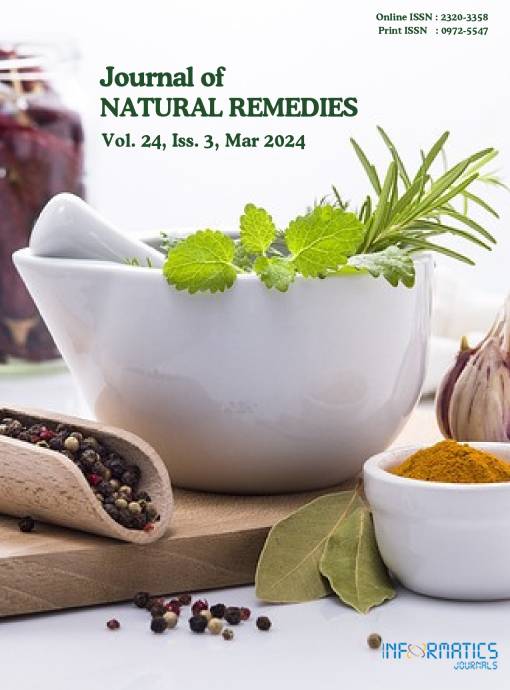In Vivo Hepatoprotective Activity of Hydroalcohol Extract of Gyrocarpus asiaticus Willd and Lactuca runcinata DC
DOI:
https://doi.org/10.18311/jnr/2024/34969Keywords:
Acute Toxicity, CCl4, Gyrocarpus asiaticus Willd, Hepatoprotective, Hepatotoxicity, Lactuca runcinata DCAbstract
Objective: Investigation of hepatoprotective activity of Gyrocarpus asiaticus Willd (GA) and Lactuca runcinata DC (LR) prepared by hydroalcohol extraction. Methodology: Albino rats were used for the in vivo experiments for the determination of oral acute toxicity study. For these experiments, 6 groups were created of which 5 groups were for each plant extract and 1 group for control. A total of 11 groups were made for the toxicity study. Each group required 2 albino mice. Different doses of 0.025, 0.2, 0.5, 2, and 5 gm/kg body weight were administered orally for each plant extract. For the control group, these were administered with distilled water. For hepatoprotective activity, albino rats were randomly divided into 5 (control, toxic, standard, 2 samples) groups, and 4 animals were randomly divided into each group. For 2 plants, a total of 7 groups were made. 5% gum acacia was used as the vehicle. For induced hepatotoxicity CCl4 and as a standard drug silymarin was used. Result and Discussion: Plant extracts did not show any toxicity, and no histopathological changes were seen in the liver, kidney, or lungs due to toxicity. In the study of GA Willd and LR DC extract prepared by hydroalcohol solution, there was evidence of protection against CCl4-induced hepatotoxicity in the Histopathological study of the liver of albino rats. Conclusion: Hydroalcohol extract of LR DC and GA Willd shows no oral acute toxicity and LR DC shows no significant hepatoprotective activity but GA Willd shows significant hepatoprotective activity
Downloads
Metrics
Downloads
Published
How to Cite
Issue
Section
License
Copyright (c) 2024 Surajit Maity Maity (Author)

This work is licensed under a Creative Commons Attribution 4.0 International License.
Accepted 2024-01-03
Published 2024-03-27
References
Girish C, Koner BC, Jayanthi S, Rao KR, Rajesh B, Pradhan SC. Hepatoprotective activity of six polyherbal formulations in paracetamol induced liver toxicity in mice. Indian Journal of Medical Research. 2009; 129(5):569-78.
Rajesh MG, Latha MS. Preliminary evaluation of the antihepatotoxic activity of Kamilari, a polyherbal formulation. Journal of Ethnopharmacology. 2004; 91(1):99-104. https://doi.org/10.1016/j.jep.2003.12.011 PMid:15036476.
Bera TK, Chatterjee K, De D, Ali KM, Jana K, Maiti S, Ghosh D. Hepatoprotective activity of Livshis, a polyherbal formulation in CCl4-induced hepatotoxic male Wistar rats: A toxicity screening approach. Genomic Medicine, Biomarkers and Health Sciences. 2011; 3(3-4):103-10. https://doi.org/10.1016/j.gmbhs.2012.03.001
Maity S, Padhy GK, Kanthal LK. Gyrocarpus asiaticus Willd and Lactuca runcinata DC: A narrative review. International Journal of Biology, Pharmacy and Allied Sciences. 2023; 12(1):1-6. https://doi.org/10.31032/IJBPAS/2023/12.1.6724
Mitra SK, Venkataranganna MV, Sundaram R, Gopumadhavan S. Protective effect of HD-03, a herbal formulation, against various hepatotoxic agents in rats. Journal of Ethnopharmacology. 1998; 63(3):181-6. https:// doi.org/10.1016/S0378-8741(98)00088-9PMid:10030721.
Jayasekhar P, Mohanan PV, Rathinam K. Hepatoprotective activity of ethyl acetate extract of Acacia catechu. Indian J Pharmacol. 1997; 29(6): p. 426.
Handa SS, Khanuja SP, Longo G, Rakesh DD. Extraction technologies for medicinal and aromatic plants. Google Scholar. 2008. p. 21-5.
Praneetha P, Rani VS, Reddy YN, Kumar BR. Hepatoprotective studies on methanolic extract of whole plant of Lindernia ciliata. Bangladesh Journal of Pharmacology. 2014; 9(4):567- 74. https://doi.org/10.3329/bjp.v9i4.20471.
Kiran PM, Raju AV, Rao BG. Investigation of hepatoprotective activity of Cyathea gigantea (Wall. ex. Hook) leaves against paracetamol-induced hepatotoxicity in rats. Asian Pacific Journal of Tropical Biomedicine. 2012; 2(5):352-6.https://doi. org/10.1016/S2221-1691(12)60055-0 PMid:23569929.
Toxicity-Up AO. OECD guideline for testing of chemicals. Organisation for Economic Co-Operation and Development. Paris, France. 2001. p. 17.
Saleem U, Amin S, Ahmad B, Azeem H, Anwar F, Mary S. Acute oral toxicity evaluation of aqueous ethanolic extract of Saccharum munja Roxb. roots in albino mice as per OECD 425 TG. Toxicology Reports. 2017; 4:580-5. https://doi.org/10.1016/j.toxrep.2017.10.005 PMid:29152463, PMCid: PMC5671618.
Reitman S. Liver enzymes (AST and ALT); Reitman and Frankel calorimetric method. Am J Uni Path. 1957; 28(1):56- 63. https://doi.org/10.1093/ajcp/28.1.56 PMid:13458125.
Bessey OA, Lowky OH, Brock MJ. A method for the rapid determination of alkaline phosphatase with five cubic millimetres of serum. Journal of Biological Chemistry. 1946; 164:321-9. https://doi.org/10.1016/S0021-9258(18)43072-4 PMid:20989492.
Kanthal LK, Satyavathi K, Bhojaraju P, Kumar MP. Hepatoprotective activity of methanolic extracts of Lactuca runcinata DC and Gyrocarpus asiaticus Willd. Beni-Suef University Journal of Basic and Applied Sciences. 2017; 6(4):321-5.https://doi.org/10.1016/j.bjbas.2017.05.002.
Liu W. On sample size determination of Dunnett’s procedure for comparing several treatments with a control. Journal of Statistical Planning and Inference. 1997; 62(2):255-61. https://doi.org/10.1016/S0378-3758(96)00193-0.

 Surajit Maity
Surajit Maity









 0.35
0.35 24
24 0.161
0.161